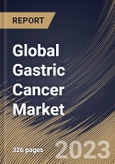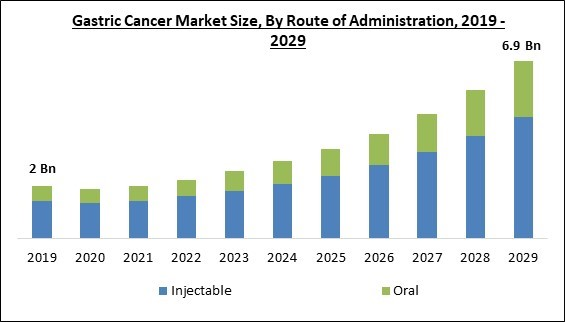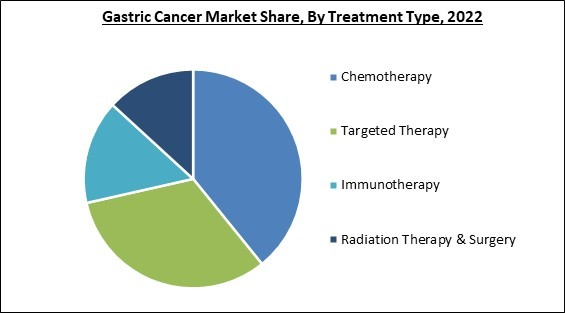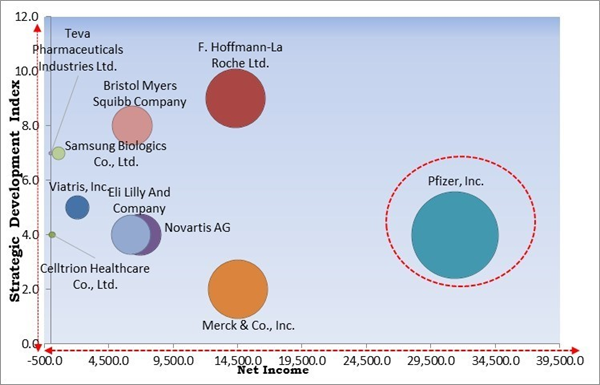The Global Gastric Cancer Market size is expected to reach $6.9 billion by 2029, rising at a market growth of 17.6% CAGR during the forecast period.
The cells lining the stomach are where gastric cancer, also known as stomach cancer, first develops. Abdominal pain, vomiting, nausea, bloating, and weight loss can all be signs of gastric cancer. Surgery, radiation therapy, chemotherapy, or a combination of these treatments are all possible forms of treatment for gastric cancer.
Cancer develops when the body's cells start to proliferate out of control. Cancerous cells can develop in almost any body portion and spread to other organs. Usually, gastric cancers grow slowly over several decades. Precancerous alterations frequently appear in the inner mucosa of the stomach before genuine cancer develops. Since these early alterations rarely have symptoms, they may go unnoticed.
Different parts of the stomach can develop cancer at different times, which can result in a variety of symptoms and prognoses. Treatment choices may vary depending on the location of the cancer. For instance, malignancies that develop into or begin at the GE junction are often staged and treated similarly to esophageal tumors. The mucosa, the stomach's innermost lining, contains gland cells that give rise to these malignancies.
The intestinal type and diffuse type of stomach adenocarcinomas are the two basic forms. The likelihood of specific gene alterations in cancer cells increases the possibility that they can be treated with targeted medication therapy. The diffuse form typically spreads more rapidly. It is less frequent than the intestinal variety, and it is frequently more challenging to treat.
The major strategies followed by the market participants are Partnerships. Based on the Analysis presented in the Cardinal matrix; Pfizer, Inc. is the major forerunner in the Gastric Cancer Market. Companies such as Merck & Co., Inc., Teva Pharmaceutical Industries Ltd., Eli Lilly, and Company are some of the key innovators in Gastric Cancer Market.
The market research report covers the analysis of key stakeholders of the market. Key companies profiled in the report include Novartis AG, Pfizer, Inc., Viatris, Inc. (Mylan N.V.), F. Hoffmann-La Roche Ltd., Eli Lilly And Company, Merck & Co., Inc., Teva Pharmaceuticals Industries Ltd., Bristol Myers Squibb Company, Celltrion Healthcare Co., Ltd., and Samsung Biologics Co., Ltd. (Samsung Bioepis Co., Ltd.).
The cells lining the stomach are where gastric cancer, also known as stomach cancer, first develops. Abdominal pain, vomiting, nausea, bloating, and weight loss can all be signs of gastric cancer. Surgery, radiation therapy, chemotherapy, or a combination of these treatments are all possible forms of treatment for gastric cancer.
Cancer develops when the body's cells start to proliferate out of control. Cancerous cells can develop in almost any body portion and spread to other organs. Usually, gastric cancers grow slowly over several decades. Precancerous alterations frequently appear in the inner mucosa of the stomach before genuine cancer develops. Since these early alterations rarely have symptoms, they may go unnoticed.
Different parts of the stomach can develop cancer at different times, which can result in a variety of symptoms and prognoses. Treatment choices may vary depending on the location of the cancer. For instance, malignancies that develop into or begin at the GE junction are often staged and treated similarly to esophageal tumors. The mucosa, the stomach's innermost lining, contains gland cells that give rise to these malignancies.
The intestinal type and diffuse type of stomach adenocarcinomas are the two basic forms. The likelihood of specific gene alterations in cancer cells increases the possibility that they can be treated with targeted medication therapy. The diffuse form typically spreads more rapidly. It is less frequent than the intestinal variety, and it is frequently more challenging to treat.
COVID-19 Impact Analysis
Delays in diagnosis & treatment have been the primary effects of the COVID-19 pandemic on gastric cancer. Delays in cancer diagnosis & treatment were the result, and they can significantly affect how patients turn out. Cancer research, particularly clinical trials looking at novel treatments for gastric cancer, has also been hampered by the pandemic. Due to COVID-19 limits, numerous clinical trials were postponed or suspended, which may be slowing down the creation of new treatments for the illness. However, the severe cases were being treated during the pandemic period. Considering these elements, the gastric cancer market witnessed a moderate impact due to COVID-19.Market Growth Factors
Growing acceptance of targeted therapy and immunotherapy and introduction of new drugs
The number of targeted medications and immunotherapy treatments being developed and introduced into the market has increased due to a better understanding of the disease's molecular foundation. Since 2010, HER-2-specific medications, such as Herceptin, have been marketed. EGFR and PD-1 targeted therapy and immunotherapies are currently being created to treat gastric cancer. Furthermore, the market for gastric cancer is also anticipated to be driven by the approval and subsequent release of medications in the clinical pipeline aiding the gastric cancer market growth.Rising Prevalence of Gastric Cancer
Gastric cancer is the most prevalent cancer type in Eastern Asia. 2020 saw an anticipated 1.1 million new cases of stomach cancer and 770 000 gastric cancer-related deaths, with male incidence rates often being twice as high as females. During the forecast period, it is anticipated that the rising prevalence of gastric carcinoma will increase demand for gastric cancer treatments and make them one of the most popular market trends for stomach cancer treatments. During the forecast period, this is expected to help the growth of the gastric cancer market.Market Restraining Factors
Limited treatment option combined with their associated side effects
Treating cancer using chemotherapy, radiation therapy, or a combination of the two with surgery is possible. The medications used in chemotherapy function by attacking rapidly dividing cancer cells; however, they can also harm healthy cells, resulting in unpleasant side effects such as nausea, vomiting, and exhaustion. In the next years, it is anticipated that this aspect will function as a barrier to the demand in the market. It is projected that factors such as high therapy costs and relatively limited availability of medications for the treatment of stomach cancer would work together to impede the growth of the gastric cancer market throughout the forecasted period.Disease Type Outlook
Based on disease type, the gastric cancer market is characterized into adenocarcinoma, lymphoma, gastrointestinal stromal tumor, carcinoid tumor, and others. The lymphoma segment covered a considerable revenue share in the gastric cancer market in 2022. The immune system's lymphocytes are where these tumors develop in the first place. There are some lymphomas that can begin in the stomach wall, while most lymphomas begin in other areas of the body. Depending on the lymphoma type and other variables, these tumors can be treated and have good prognoses. The rising awareness of the lymphoma are predicted to support the segment’s expansion.Treatment Type Outlook
On the basis of treatment type, the gastric cancer market is classified into immunotherapy, targeted therapy, chemotherapy, and radiation therapy & surgery. The targeted therapy segment acquired a substantial revenue share in the gastric cancer market in 2022. With targeted therapy, cancer patients receive treatment by having pharmaceuticals that specifically target the genes or proteins that the cancer cells have. Targeted therapy for cancer comes in various forms, including hormonal treatments, gene expression regulators, angiogenesis inhibitors, apoptosis inducers, signal transduction inhibitors, and several more.Drug Class Outlook
By drug class, the gastric cancer market is divided into PD-1/PD-L1 inhibitors, HER2 antagonists, VEGFR2 antagonists, and others. In 2022, the PD-1/PD-L1 inhibitors segment dominated the gastric cancer market with the maximum revenue share. Immune checkpoint proteins such as programmed cell death protein 1 (PD-1) and PD-L1 often aid in preventing overactive immune responses that may harm healthy tissues. For the treatment of severe or metastatic gastric cancer, a number of PD-1/PD-L1 inhibitors, such as nivolumab, pembrolizumab, and atezolizumab, have been licensed. In patients with advanced gastric cancer, several medications have demonstrated effectiveness in extending survival and slowing tumor growth.Route of Administration Outlook
Based on route of administration, the gastric cancer market is segmented into oral and injectable. In 2022, the injectable segment registered the maximum revenue share in the gastric cancer market. Since injectable pharmaceuticals are administered directly into the bloodstream, they can be absorbed faster than oral medicines. This helps individuals with advanced or metastatic stomach cancer, where quick action may be required. More of the drug can reach its target site when it is administered intravenously, which increases bioavailability. Less side effects and better therapeutic outcomes may arise from this.Distribution Channel Outlook
On the basis of distribution channel, the gastric cancer market is classified into specialty & retail pharmacies, hospital pharmacies, and others. The hospital pharmacies segment projected a prominent revenue share in the gastric cancer market in 2022. The creation of government-sponsored hospitals pharmacies as well as advantageous reimbursement are the main causes of the hospital pharmacy segment's growth. These reasons together with the strong support the government has provided for cancer treatment. The segment is also predicted to expand as a result of the growing patient pool, growing prevalence of stomach cancer, and increasing number of cancer treatment facilities.Regional Outlook
Region wise, the gastric cancer market is analyzed across North America, Europe, Asia Pacific, and LAMEA. In 2022, the Asia Pacific region led the gastric cancer market by generating the largest revenue share. The expansion of the market is being driven by the rise in the geriatric population in the Asia-Pacific region. The demand for gastric cancer diagnostics has been driven by the prevalence of gastrointestinal tumors and lymphomas. Furthermore, the rising case of gastric cancer in the region is anticipated to propel the market growth in the Asia Pacific during the projected period.The Cardinal Matrix - Gastric Cancer Market Competition Analysis
The major strategies followed by the market participants are Partnerships. Based on the Analysis presented in the Cardinal matrix; Pfizer, Inc. is the major forerunner in the Gastric Cancer Market. Companies such as Merck & Co., Inc., Teva Pharmaceutical Industries Ltd., Eli Lilly, and Company are some of the key innovators in Gastric Cancer Market.
The market research report covers the analysis of key stakeholders of the market. Key companies profiled in the report include Novartis AG, Pfizer, Inc., Viatris, Inc. (Mylan N.V.), F. Hoffmann-La Roche Ltd., Eli Lilly And Company, Merck & Co., Inc., Teva Pharmaceuticals Industries Ltd., Bristol Myers Squibb Company, Celltrion Healthcare Co., Ltd., and Samsung Biologics Co., Ltd. (Samsung Bioepis Co., Ltd.).
Recent Strategies Deployed in Gastric Cancer Market
Partnerships, Collaborations and Agreements:
- Feb-2023: Pfizer came into collaboration with Tempus, a technology company focused on advancing precision medicine through the practical application of artificial intelligence in healthcare. Following the collaboration, Pfizer would access Tempus' AI-based platform and multimodal data library, together with its clinical trial matching program and companion diagnostic development capabilities.
- Jan-2023: Roche signed an agreement with CHEPLAPHARM, following which the latter company took the commercial rights from Roche for Xeloda (capecitabin) in China. Early in 2022, CHEPLAPHARM already had the rights for the extremely potent anti-cancer drug in every country except China and Japan. By incorporating China, CHEPLAPHARM improves its cancer product line and increases its market share in the world's second-largest pharmaceutical market. In 1997, Xeloda® received approval in China for use as a prescription drug. Shanghai Roche Pharmaceuticals got permission from China's State FDA in 2007 to treat advanced gastric cancer, metastatic breast cancer, and colorectal cancer.
- Jan-2023: Roche extended its collaboration with CARsgen Therapeutics Holdings Limited, a manufacturer of innovative therapies for the treatment of solid tumors and hematologic malignancies. Following the expansion, the companies aim to evaluate CARsgen's investigational drug AB011, the first humanized monoclonal antibody against Claudin18.2 (CLDN18.2) that received IND clearance across the world, together with atezolizumab, Roche's PD-L1 checkpoint inhibitor, along with standard-of-care chemotherapy in patients with gastric or gastroesophageal junction carcinoma. In addition, Roche will be in charge of operating and conducting the research while both businesses would split the costs of the study's AB011 treatment arms.
- Marr-2022: Celltrion Healthcare announced that they have got the tender in Brazil, from the Brazilian Federal Government to procure the world’s first monoclonal antibody biosimilar Remsima (infliximab). Additionally, the company has won 12 State bids in Brazil to supply Remsima, including the largest state in Brazil Sao Paulo.
- Mar-2022: Bristol Myers Squibb announced a clinical collaboration with Transcenta Holding Limited, a clinical-stage biopharmaceutical company, for the evaluation of the combination of TST001, an investigational humanized monoclonal antibody targeting Claudin18.2 created by Transcenta, with Opdivo® (nivolumab), Bristol Myers Squibb's anti-PD-1 therapy. This has been indicated for the treatment of unresectable locally advanced or metastatic gastric cancer or gastroesophageal junction cancer (GC/GEJ).
- Feb-2022: Bristol Myers Squibb and Ono Pharmaceutical signed an agreement with Prime Research Institute for Medical RWD, Inc. for an industry-sponsored, large-scale, multi-institutional clinical research on gastric cancer patients treated with Opdivo together with chemotherapy. The study would utilize the PRiME-R's "CyberOncology®" data entry support system, which standardizes, organizes, manages, and integrates real-world data in routine cancer clinical practice.
- Sep-2021: Roche Diagnostics International came into an agreement with Medical EarlySign, a company focused on developing ML-based decision support tools, for commercializing an AI tool that would detect cancer early. Following the agreement, the companies create the product, clinically validate it, and then market it. The companies would initially concentrate on the field of stomach cancer. EarlySign's software, which includes lab findings, EHR data, and other clinical care, is used in the clinical decision support tool.
- Jun-2021: Eli Lilly and Company signed a clinical trial and supply agreement with ALX Oncology, a clinical-stage immuno-oncology company. Following the agreement, the companies aimed to evaluate the combination of Lilly’s anti-VEGFR2 antibody, and ALX148, a next-generation CD47 blocker, for the treatment of HER2-positive gastric cancer or gastroesophageal junction cancer patients.
- Feb-2021: Novartis Pharma announced a collaboration and license agreement with BeiGene, Ltd., a biotechnology company engaged in the development and commercialization of innovative medicines. The agreement was focused on developing, manufacturing, and commercializing BeiGene’s anti-PD-1 antibody tislelizumab in the US, Mexico, Canada, and member countries of the European region, Norway, United Kingdom, Iceland, Switzerland, Russia, Liechtenstein, and Japan. Additionally, both businesses may perform clinical studies around the world to investigate pairings of tislelizumab with other cancer therapies, and BeiGene has the option to co-develop the medicine in North America with Novartis’ financial support.
Product Launches and Product Expansions:
- Aug-2020: Samsung Bioepis unveiled Ontruzant (trastuzumab), a biosimilar referencing Roche’s Herceptin, in Brazil. Ontruzant (150 mg single-dose vials) has been authorized for the treatment of advanced gastric cancer, metastatic HER2-overexpressing breast cancer, and early HER2-overexpressing breast cancer by the Agência Nacional de Vigilância Sanitária (ANVISA), the country's health regulatory body. It was launched in the United States in April 2020.
- Mar-2020: Teva Pharmaceuticals USA, Inc., a division of Teva, together with Celltrion Healthcare, announced the availability of HERZUMA®1 (trastuzumab-pkrb) for Injection, a biosimilar to HERCEPTIN®1 in the United States. HERZUMA is approved in combination with cisplatin, capecitabine, or 5-fluorouracil for the treatment of patients with HER2-overexpressing metastatic gastric or gastroesophageal junction adenocarcinoma who have not previously undergone treatment for metastatic disease.
Approvals & Trials:
- Jun-2022: Eli Lilly and Company and Innovent Biologics, Inc., a biopharmaceutical company, received approval from the National Medical Products Administration (NMPA) of China for the supplemental New Drug Application (sNDA) for TYVYT® (sintilimab injection) together with fluorouracil and platinum-based chemotherapy for the first-line treatment of unresectable, locally advanced, recurrent, or metastatic gastric or gastroesophageal junction adenocarcinoma.
- Feb-2022: Samsung Bioepis got approval for ONTRUZANT® (also known as SB3), a biosimilar referencing Herceptin ®i (Trastuzumab) from Health Canada. This biosimilar is used for the treatment of Early Breast Cancer, metastatic gastric cancer (MGC), and Metastatic Breast Cancer (MBC), among adults.
- Oct-2021: Bristol Myers Squibb got approval from European Commission for Opdivo (nivolumab) in combination with fluoropyrimidine- and platinum-based combination chemotherapy. This biosimilar is utilized for first-line treatment of adult patients with gastroesophageal junction (GEJ), HER2-negative advanced or metastatic gastric, or esophageal adenocarcinoma (EAC) whose tumors express PD-L1 with a combined positive score (CPS) ≥ 5.
- Apr-2021: Bristol Myers Squibb received approval from the U.S. Food and Drug Administration (FDA) for Opdivo (nivolumab) (injection for intravenous use), in combination with fluoropyrimidine- and platinum-containing chemotherapy. This biosimilar is utilized for the treatment of patients with gastroesophageal junction cancer, advanced or metastatic gastric cancer, and esophageal adenocarcinoma, regardless of PD-L1 expression status.
Scope of the Study
By Route of Administration
- Injectable
- Oral
By Treatment Type
- Chemotherapy
- Targeted Therapy
- Immunotherapy
- Radiation Therapy & Surgery
By Disease Type
- Adenocarcinoma
- Carcinoid Tumor
- Gastrointestinal Stromal Tumor
- Lymphoma
- Others
By Distribution Channel
- Specialty & Retail Pharmacies
- Hospital Pharmacies
- Others
By Drug Class
- PD-1/PD-L1 Inhibitors
- HER2 Antagonists
- VEGFR2 Antagonists
- Others
By Geography
- North America
- US
- Canada
- Mexico
- Rest of North America
- Europe
- Germany
- UK
- France
- Russia
- Spain
- Italy
- Rest of Europe
- Asia Pacific
- China
- Japan
- India
- South Korea
- Singapore
- Malaysia
- Rest of Asia Pacific
- LAMEA
- Brazil
- Argentina
- UAE
- Saudi Arabia
- South Africa
- Nigeria
- Rest of LAMEA
Key Market Players
List of Companies Profiled in the Report:
- Novartis AG
- Pfizer, Inc.
- Viatris, Inc. (Mylan N.V.)
- F. Hoffmann-La Roche Ltd.
- Eli Lilly And Company
- Merck & Co., Inc.
- Teva Pharmaceuticals Industries Ltd.
- Bristol Myers Squibb Company
- Celltrion Healthcare Co., Ltd.
- Samsung Biologics Co., Ltd. (Samsung Bioepis Co., Ltd.)
Unique Offerings
- Exhaustive coverage
- The highest number of Market tables and figures
- Subscription-based model available
- Guaranteed best price
- Assured post sales research support with 10% customization free
Table of Contents
Chapter 1. Market Scope & Methodology
Chapter 2. Market Overview
Chapter 3. Competition Analysis - Global
Chapter 4. Global Gastric Cancer Market by Route of Administration
Chapter 5. Global Gastric Cancer Market by Treatment Type
Chapter 6. Global Gastric Cancer Market by Disease Type
Chapter 7. Global Gastric Cancer Market by Distribution Channel
Chapter 8. Global Gastric Cancer Market by Drug Class
Chapter 9. Global Gastric Cancer Market by Region
Chapter 10. Company Profiles
Companies Mentioned
- Novartis AG
- Pfizer, Inc.
- Viatris, Inc. (Mylan N.V.)
- F. Hoffmann-La Roche Ltd.
- Eli Lilly And Company
- Merck & Co., Inc.
- Teva Pharmaceuticals Industries Ltd.
- Bristol Myers Squibb Company
- Celltrion Healthcare Co., Ltd.
- Samsung Biologics Co., Ltd. (Samsung Bioepis Co., Ltd.)
Methodology

LOADING...











